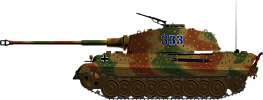Ugh I've seen that before. It used to come up on warships1 about once a year. But usually by people with idle questions, not attempting to argue in favor of the idea. Anyone doing that is ignorant of every possible aspect of the subject.AniThyng wrote:How realistic are the fire chances relatively? I see some people on the forums whinging that HE doesn't star fires but WP does. This seems....unlikely in that I'm sure no one shoots WP at warships...
WP is actually not really an effective incendiary in military terms, and if one understands why we use it as a smoke round that makes perfect sense. It makes so much smoke because it absorbs a colossal amount of water vapor out of the air, binds with it and turns it all into a white cloud. This process also absorbs large amounts of combustion heat, suppressing its ability to start fires. As well the burning time is very low, which is not desirable for an incendiary weapon.
If anyone wanted to build a proper incendiary shell, real life already tells us they'd use thermite, this was done multiple times in the world wars, and was also the filler of choice for aircraft bombs. Though napalm was even cheaper and in some respects better, once invented. In fact when WW2 ended the US was working on a 5in base ejecting (four canisters with ignitors, rather like a smoke shell) thermite shell so submarines could burn Japanese sampans more easily, earlier work to make a napalm filled shell failed to produce a suitable weapon. The US Army found WP shells to be poor at starting fires for the number of rounds expended when it sought to use them for difficult purposes like burning trees and even framed buildings. It never got its desired thermite shells though, except IIRC some mortar rounds.
High explosives produce more then enough heat energy to ignite highly flammable materials however, they just won't burn items which require a sustained flame to ignite. So fuel, ammo, and paint, those can be ignited, but not a lot of other things on a ship stripped and prepared for action. However a pure incendiary would not do much better, since it would be unable to break open stores of flammables.
The vulnerability of steel warships to fire was a matter of detail design, storage of flammables (progressively improved in the war, such as scraping all the excessive up to half inch thick paint off) and hit placement. Hit placement is key. An exploding shell releases a hail of fragmentation which can rupture pipes, break open sealed powder cans, vaporize and spall paint, open up ventilation paths and generally do a lot of things to increase the risk of fire. It can also cause major structural damage, leading to sometimes lethal flooding (cases exist of destroyers sunk by single shells bursting on the hull bottom, and riddling all the machinery bulkheads with fragments at the same time), wrecked machinery beyond repair and in extreme causes induce structural breakup of the ship. Though really only destroyers were all that vulnerable to breakup from gunfire, larger ships would just about always get sunk or blown up first. Aerial bombing was a different story.
A WP filled shell would not do any of this, it would burst on impact with almost anything, create a short, localized fire that can be suppressed with water unless it ignites fuel or ammo, both of which HE will also do. HE filled Shells bursting deeply inside the ship are far more likely to reach those sort of material fires.
WP won't get deep because its highly vulnerable to shock. That's the final deal killer. So even if you attempted to make a WP round that would penetrate, it'd stand a high chance of being set off by the shear force of impact of a steel shell striking a steel plate. This is bad. This was a problem even with even much more stable high explosives, and took a lot of experience and experimentation to deal with. If a WP round hit a ships hull it might burst on impact so quickly the WP would splatter into the water (it has to come out the bottom of the shell afterall, the nose is too strong, or else you need a large HE burster anyway!) For certain it would be utterly defeated by not just thin armor, but even the main structure of large ships which could have plates an inch and a half thick in them just for strength.
As it was in reality most 'HE' rounds carried by warships were actually base fused SAP rounds designed to penetrate light armor, and deeply into unarmored targets so they could damage vital systems, and not be stopped by something like the hull frames, which could be some rather large beams. The basic structure of a ship otherwise offered great resistance to bursts on the hull plate and upper works. AS well most people don't understand it, but most of the blast and fragmentation from any conical shell is radial, not a sphere. So if the shell bursts against the outside of the hull or superstructure the effectiveness is immensely reduced. Some navies issued no nose fused HE rounds at all to guns bigger then 5in, or only in tiny numbers for special purposes.
Aiming to set fire to ships is an okay game mechanic, but it has little connection to reality. Combat throughout the world warships, and before (Chinese battleships at the Yaul steamed home with as many as 200 hits on each) generally indicated that the 'soft kill' threat was not serious as it was. And of course in real life battleships had secondary guns that actually worked.

